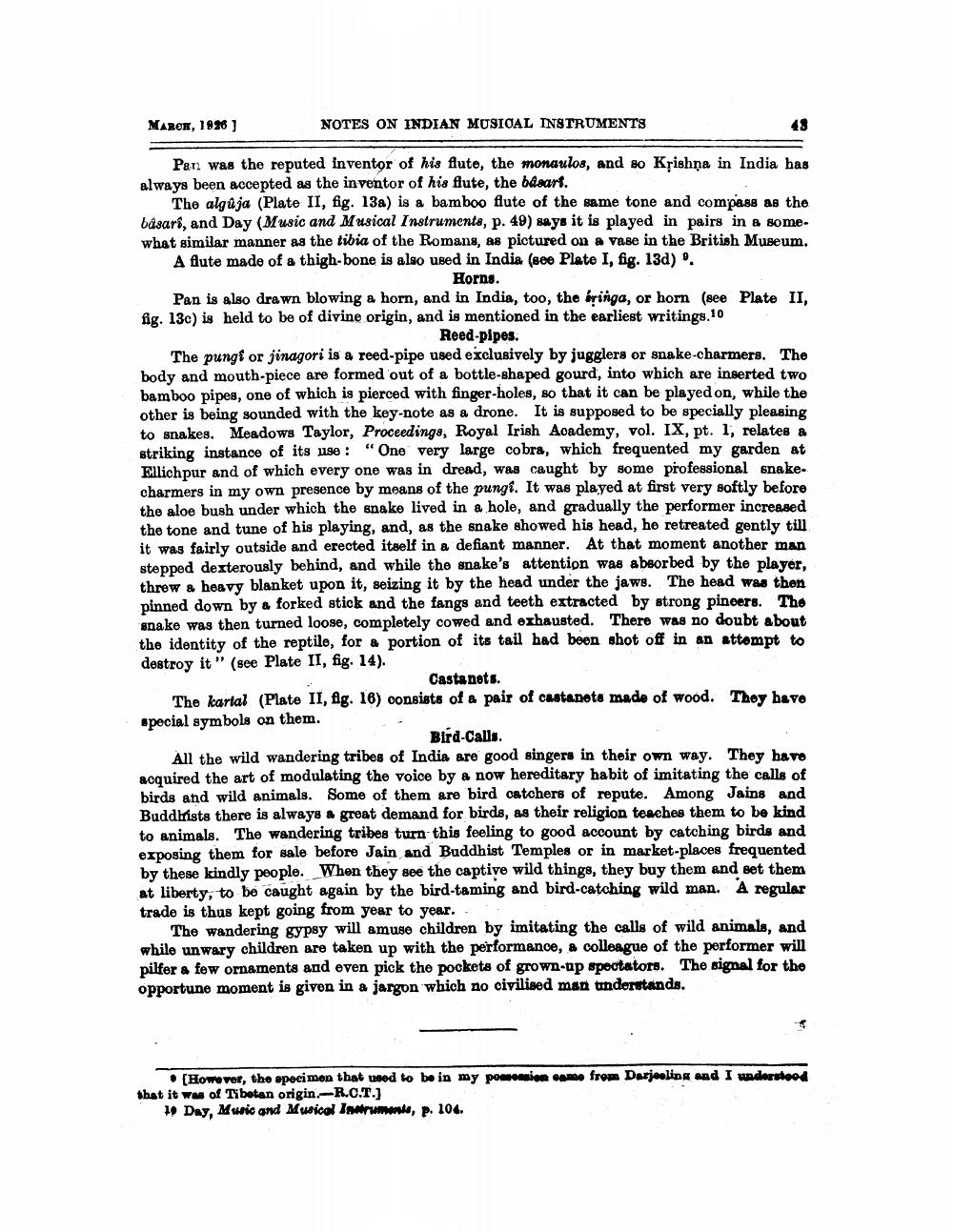________________
NOTES ON INDIAN MUSICAL INSTRUMENTS
MARCH, 1926]
Pan was the reputed inventor of his flute, the monaulos, and so Krishna in India has always been accepted as the inventor of his flute, the basart.
43
The algúja (Plate II, fig. 13a) is a bamboo flute of the same tone and compass as the básars, and Day (Music and Musical Instruments, p. 49) says it is played in pairs in a somewhat similar manner as the tibia of the Romans, as pictured on a vase in the British Museum. A flute made of a thigh-bone is also used in India (see Plate I, fig. 13d) ".
Horns.
Pan is also drawn blowing a horn, and in India, too, the iringa, or horn (see Plate II, fig. 13c) is held to be of divine origin, and is mentioned in the earliest writings.10
Reed-pipes.
The pungi or jinagori is a reed-pipe used exclusively by jugglers or snake-charmers. The body and mouth-piece are formed out of a bottle-shaped gourd, into which are inserted two bamboo pipes, one of which is pierced with finger-holes, so that it can be played on, while the other is being sounded with the key-note as a drone. It is supposed to be specially pleasing to snakes. Meadows Taylor, Proceedings, Royal Irish Academy, vol. IX, pt. 1, relates a striking instance of its use: "One very large cobra, which frequented my garden at Ellichpur and of which every one was in dread, was caught by some professional snakecharmers in my own presence by means of the pungi. It was played at first very softly before the aloe bush under which the snake lived in a hole, and gradually the performer increased the tone and tune of his playing, and, as the snake showed his head, he retreated gently till it was fairly outside and erected itself in a defiant manner. At that moment another man stepped dexterously behind, and while the snake's attention was absorbed by the player, threw a heavy blanket upon it, seizing it by the head under the jaws. The head was then pinned down by a forked stick and the fangs and teeth extracted by strong pineers. The snake was then turned loose, completely cowed and exhausted. There was no doubt about the identity of the reptile, for a portion of its tail had been shot off in an attempt to destroy it" (see Plate II, fig. 14).
Castanets.
The kartal (Plate II, fig. 16) consists of a pair of castanets made of wood. They have special symbols on them.
Bird-Calls.
All the wild wandering tribes of India are good singers in their own way. They have acquired the art of modulating the voice by a now hereditary habit of imitating the calls of birds and wild animals. Some of them are bird catchers of repute. Among Jains and Buddhists there is always a great demand for birds, as their religion teaches them to be kind to animals. The wandering tribes turn this feeling to good account by catching birds and exposing them for sale before Jain and Buddhist Temples or in market-places frequented by these kindly people. When they see the captive wild things, they buy them and set them at liberty, to be caught again by the bird-taming and bird-catching wild man. A regular trade is thus kept going from year to year.
The wandering gypsy will amuse children by imitating the calls of wild animals, and while unwary children are taken up with the performance, a colleague of the performer will pilfer a few ornaments and even pick the pockets of grown-up spectators. The signal for the opportune moment is given in a jargon which no civilised man understands.
[However, the specimen that used to be in my possession came from Darjeeling and I understood that it was of Tibetan origin.-R.C.T.]
19 Day, Music and Musical Instruments, p. 104.




